Trouble in the High-Rise Hothouse
Big indoor farms are attracting big investments. But transforming agriculture might depend on putting nanofarms everywhere — maybe even in your home.
This was written for proto.life in association with NOVA Next/WGBH Boston.
Paul Gauthier, a plant physiologist at Princeton University, took a short drive up the New Jersey Turnpike to try to figure out whether the biggest vertical farm on the East Coast is succeeding. The answer isn’t as clear as you might think.
AeroFarms, which runs a 70,000 square-foot operation in Newark, is one of the highest-profile companies founded on the premise that growing crops indoors will transform agriculture. These aeroponic indoor farms stack leafy greens and herbs on racks that nurture the produce with sprays of mist and light from LEDs or high-pressure sodium lamps. They use no soil or pesticides, and can operate year-round. For further efficiency, AeroFarms mechanizes the seeding, harvesting, packaging, and cleaning of its produce.
It requires a great deal of electricity to give plants the light and heat they could get for free outdoors. But the idea is that vertical farms in big urban centers will be less costly—both economically and for the environment—because of the inputs they avoid, like toxic chemicals and long-distance transportation to consumers.
So do they actually come out ahead? Gauthier studies the science and the economics of growing food indoors, and he wants it to work. But the indoor farms getting glamour-puss investments refuse to release their numbers. And after touring several of them, digging into their methods to weigh the costs and the benefits, he’s suspicious about whether the numbers add up.
If you ask him whether the farms are making money or on track for any real financial viability, Gauthier, raised in Nantes and trained there and in Paris, where he earned his Ph.D, does a French thing with his mouth that translates to an existential shrug. “Who knows? So they say.” But he’s pretty sure that economics is a “major part of what’s stopping vertical farms from growing.”
Feeding 10 billion people in a world stressed by the rapidly changing climate is going to require constant innovations in how food is produced—a new green revolution, just this time not involving methods that wreck soil and water. But while vertical farms might work as a technical concept, thriving as businesses is another matter.
The problem, Gauthier suspects, is that the future of indoor agriculture might not look like a venture capitalist’s dream, with microgreens and other fancy kinds of lettuce sold at macro markups. To have a truly global impact, the startups ideally would also be researching how to grow staple crops threatened by climate change and trying to maximize their nutritional value. And, Gauthier and others argue, these agricultural startups should be thinking small at the same time—encouraging cottage and studio-apartment farmers to raise indoor tomatoes and strawberries themselves and join what could become an information-sharing revolution.
“Stupid designs”
Gauthier, who has been at Princeton’s geosciences department for six years, has a typical academic’s curiosity but also a French touch of mischief. He considered medical school, he says, but “then someone told me that even if we cure all the diseases on earth, people will still have to eat. Plus plants are cool.”
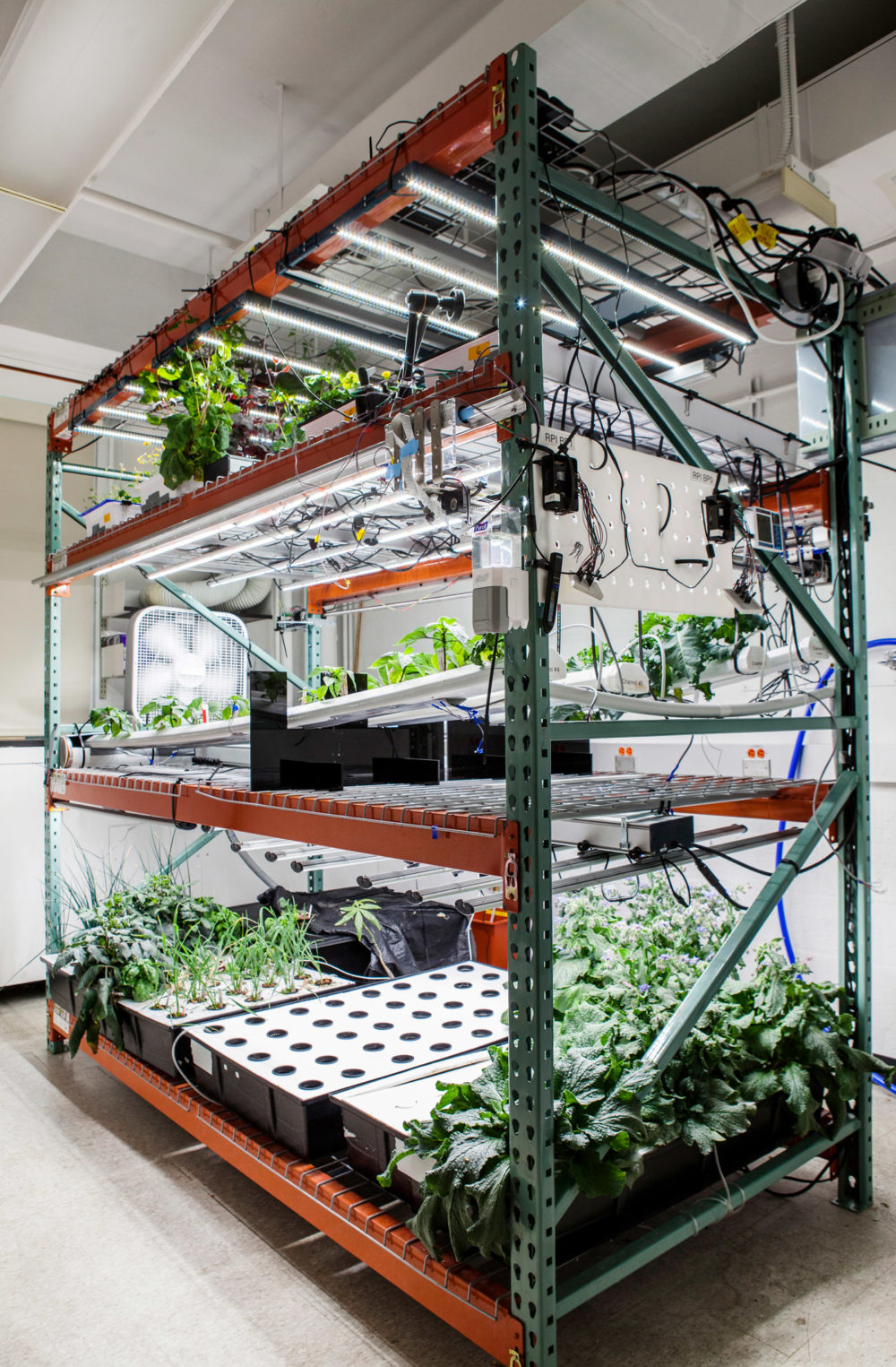
And nothing sounded cooler than saving the world by growing its food indoors, right where rapidly expanding urban populations need it. But he was baffled by the wildly optimistic predictions he read and heard for vertical farming. A widely cited 2013 study by German economists at the Macrothink Institute made the case that vertical farms in high-density urban areas, particularly in India and China, could be cost-effective because of the transport costs they would save. And they could increase access to food and reduce hunger in the bargain.
But the claims being made for the majority of vertical farms were, Gauthier says, unbacked by current, deep, and comparative data. “As a scientist, this wasn’t acceptable,” he says. “A lot of what they said was just marketing.” So two years ago he launched Princeton’s Vertical Farming Project to understand what can and can’t work economically.
He regarded with a beady eye the Ivy League grads applying for investment and Silicon Valley venture capitalists funding indoor vertical farms. Where they see a future full of urban warehouses and exurban hangars repurposed to grow food, he sees a bubble likely to burst too soon, with all those massive buildings more likely to be eventually repurposed for marijuana — the one indoor crop guaranteed to turn a profit.
Lettuce, microgreens, and herbs—the primary crops of vertical farms—have a high markup relative to, say, brussels sprouts, and being highly perishable suits them to very short transport time from indoor farm to store. But not many other commercial crops check those same boxes. Some vertical farms market kale, which is an odd choice, because it’s dirt cheap. Why bother? Gauthier leans over as if imparting a big secret: “Because anyone can grow kale, and it grows everywhere.”
Vertical farms might work as a technical concept. Thriving as businesses that transform agriculture is another matter.
Anything grown in a vertical farm might sell in China, where contaminated-food scandals mean consumers will pay a premium for food they consider to be safe, like that of fast-food chains. Vertical farms use little water and don’t need pesticides or fertilizers, all of which can be sources of contamination. So it could be smart that the most highly capitalized vertical farm company — Plenty, based in San Francisco, which has raised more than $200 million — plans to build 300 vertical farms in China.
It also would be wise to diversify the number and kind of crops in vertical farms. That optimistic German study from 2013 was based on a simulation of a farm that would grow not just vegetables but also tilapia, in tanks. Variety of output protects any business against the collapse of any one product — but that isn’t the current practice in vertical farms. Why? Perhaps because new startups follow the examples of others that seem to be successful. Perhaps because research on protein-rich products like chickpeas or fish is less evolved than it is for easy-to-grow, easy-to-sell bagged lettuce. Perhaps because different crops require different amounts of light, humidity, and nutrients and thus make for less-efficient production in a single space. David Rosenberg, cofounder and CEO of AeroFarms, says his company has experimented with growing 700 different plants. Nonetheless, 98 percent of the production consists of baby greens. The rest is microgreens. Microgreens can fetch $40 a pound, but Rosenberg is proud to have turned baby greens profitable, as they usually go for a much lower price to stay competitive—just $6 a pound.
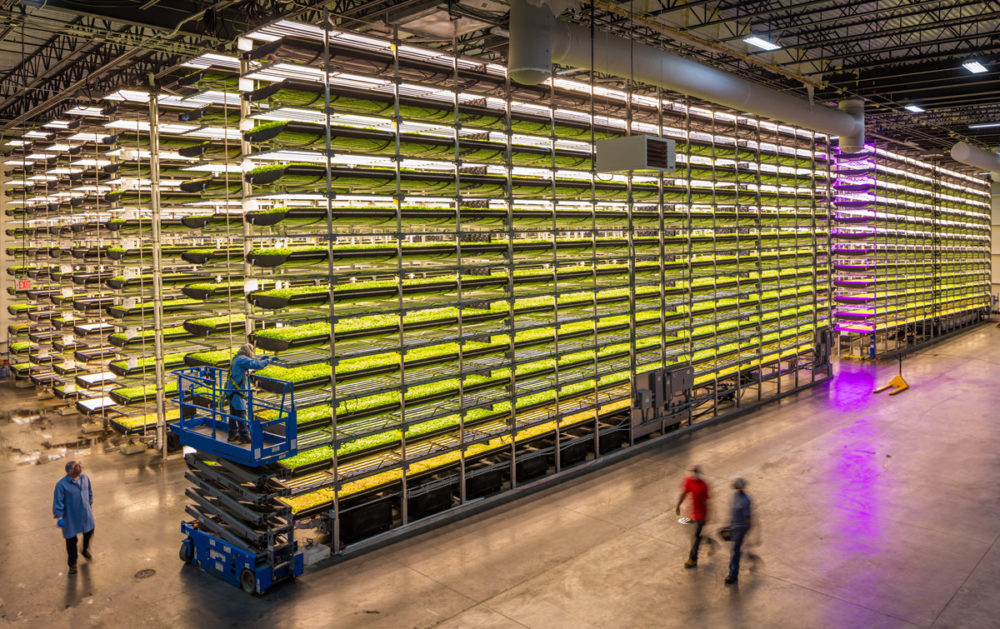
More diversified crops are possible to grow together in vertical farms — and economically safer in the long run, Gauthier thinks. But the business models might be trickier to construct for startups looking for funding. He has two indoor test gardens, one on wire shelves in a side room off his lab in the atmospherically collegiate Princeton geosciences building, and one a bit outside of the tony, horsey town of Princeton. In these little indoor gardens he grows particularly sweet strawberries he’s proud of. They don’t grow efficiently enough, though, to appeal to today’s commercial vertical farms.
Though Rosenberg won’t disclose whether AeroFarms is profitable, he shares much of Gauthier’s general skepticism about many of his competitors in vertical farming. In a keynote address to an indoor-farming conference last year, he predicted that 60 to 90 percent of indoor farms would fold within three years of starting. Some already have gone bankrupt.
Rosenberg says not enough of them truly understand how costly their build-outs and operations will be before their first robot plants a seed in ecologically ultra-responsible growth medium. He says he and his team of 120 workers, most of them engineers, have learned this from several years of expanding into four buildings in downtown Newark. “Biological systems scale in non-obvious ways,” he says.
In the last year alone, he says, four companies that were going out of business approached him to buy their assets. Those companies had “stupid designs,” he says. “They lost before they got going.”
Lettuce, microgreens, and herbs have a high markup, and being highly perishable suits them to very short transport time from indoor farm to store. But not many other commercial crops check those same boxes.
In general, Gauthier says, energy for lighting and climate control accounts for as much as 60 to 70 percent of operational overhead in a vertical farm. Add in labor costs, which are higher in the urban areas where vertical farms are located, and the farm is likely to have, at best, a profit margin of 4 to 5 percent. That’s more than what’s reaped by most U.S. farms, which are strapped by international competition and the current trade war. Even 4 to 5 percent, though, is nothing to venture funders, who look for profitability of 10, 15, 20 percent and beyond. (Rosenberg, without disclosing specifics of AeroFarms’ business, says those fatter profit margins are indeed possible—but only if debt-service and real-estate costs are low, and if many processes are mechanized.)
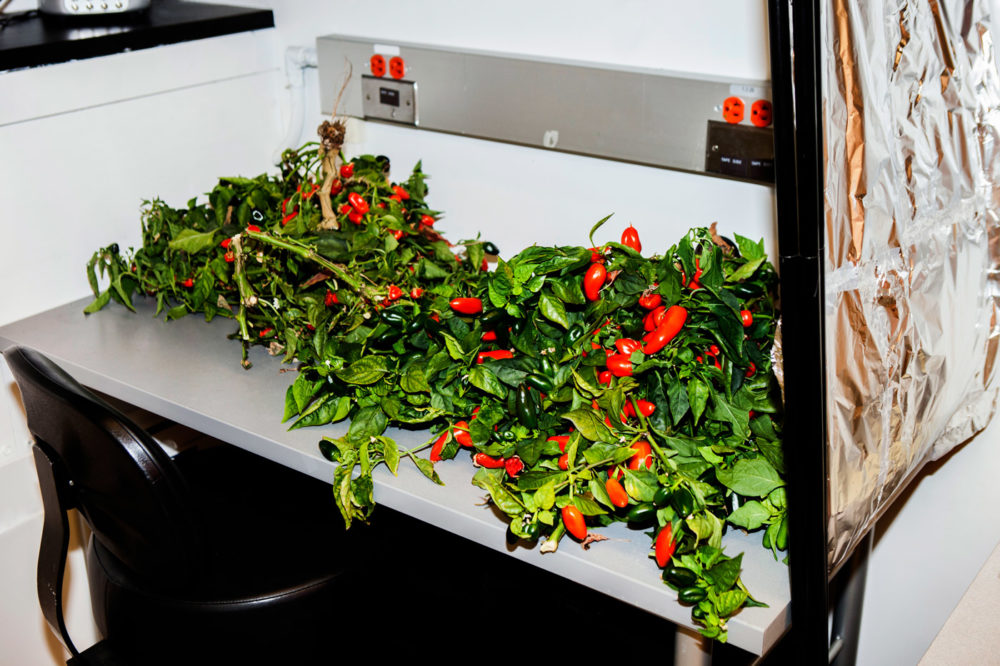
The danger, Gauthier thinks, is not that a few well-funded farms will turn only a modest profit growing niche crops to be sold by boutiques whose customers can afford high markups. It’s that many indoor farms will fail, because anyone who tries the things he thinks would best serve the industry — crop diversity within the same indoor space, research into lower-margin staples like wheat that are threatened by climate change, efficient techniques for growing high-protein crops — won’t appeal to funders who expect too much too soon.
Micro-farm in the rec room
Vertical farmers might have a better chance of nailing the math if they had real-world data about what works. And that’s hard to come by. Those well-funded indoor farms keep their data secret: the costs of buildout and climate control and labor; how plant growth varies with the nutrients they feed plants; the amount and color of the light and heat and humidity and growing time for each one, the prices the harvests fetch.
What if a lot more of that data were widely available to anyone who wanted to transform agriculture by bringing it indoors, anywhere in the world? How expensive are the lights, shelves, aeration, and hydration and climate-control systems? How long do they take to amortize? How do different plants grow indoors in different places and conditions — not just the sterile, ultra-controlled-atmosphere buildings stacked 37 stories high, the utopia conjured in endless vertical farm stories?
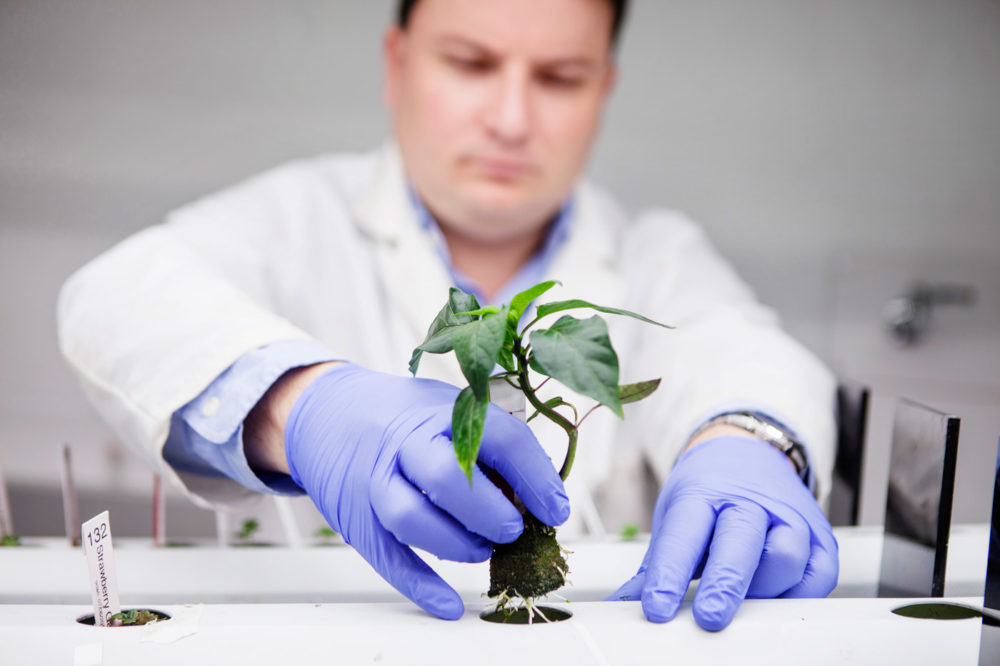
Gauthier envisions a much broader ecosystem: a future of thousands upon thousands of farms, in basements and bedroom corners, growing strawberries and basil and lettuce and tomatoes, uploading data to central servers that help cottage growers all over the world as well as larger-scale indoor farmers. “Everybody has a basement or a corner,” Gauthier says. Only 15 minutes of tending a day max, he promises. And if the climate isn’t perfect and the lighting is not custom-tailored for one plant, well, people’s gardens in real life aren’t so tailored either.
These micro-farms in every rec room, study nook, and garage would be simple — no need for the colored lights that large-scale vertical farms use. Just full-spectrum LEDs of the kind Gauthier has in his pocket-sized lab farm. The vivid light in the space makes it warm and inviting, unlike the compact fluorescent light over his research assistants in the next room. “People come here and say, ‘I could put my desk here,’” he says. Just being here and fussing with his leggy strawberry and basil plants visibly brightens Gauthier’s mood.
Why would you follow his suggestion and buy the makings for your own basement or closet? The same reason that inspires window-box and patio gardeners everywhere: to have fresh food you’ve grown yourself, for pennies on the dollar and the kind of brightness of flavor those bright lights suggest. And unlike with window boxes and mini-terraces, indoor gardens would flourish independent of weather.
Turning basil into data
Caleb Harper, of MIT’s Media Lab, also has very large ambitions for very little indoor farms all over the world. He founded the Open Agriculture Initiative, or OpenAg, with open-source data, hardware, and software as founding principles. He wants to create more “digital farmers” around the world by making how-to information and tools easily available to them, and he hopes to connect them so they do the neighborly tip-sharing that used to take place at the feed and seed store.
One of Harper’s first moves, in 2015, was to release designs for a prototype “food computer,” a kit that creates a milk-carton-sized, digitally controlled hydroponic growing environment for even, say, one stalk of basil. That was version one, and the costs for materials ran from $2,500 to $4,000 for a souped-up model. The most recent version, V3, costs about $500. Its starter equipment includes a “central nervous system” that incorporates a printed circuit board, USB camera, LED lights, fans, and sensors to measure temperature, humidity, and carbon dioxide. Wi-Fi-connected processors in the box upload millions of pieces of data about the plant’s progress to cloud servers that help others replicate and share their results.
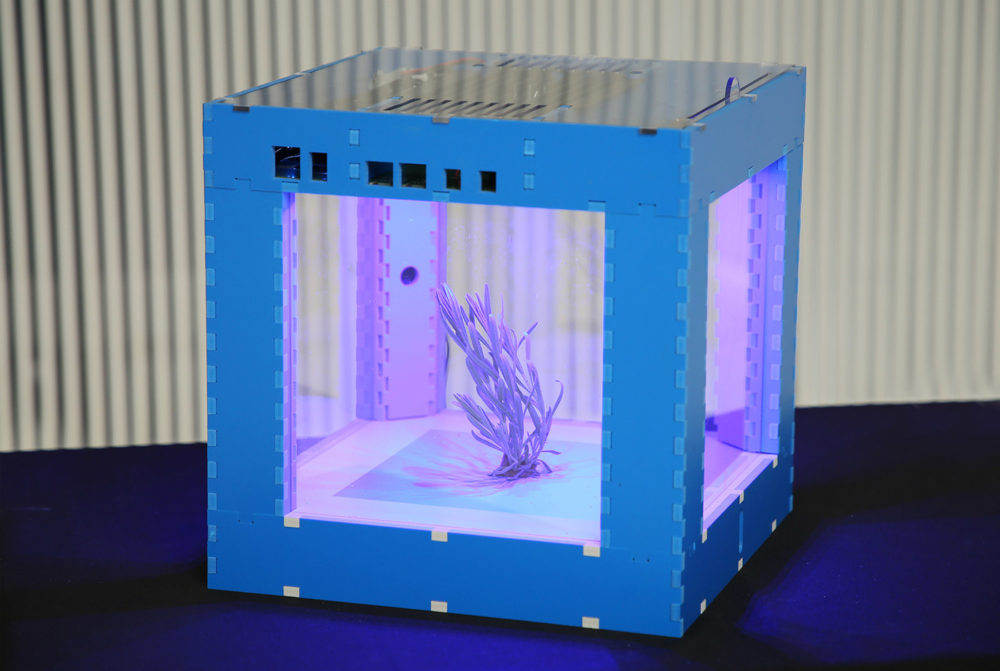
Harper’s idea, like Gauthier’s, is that the more information that indoor farmers around the world share — the levels of irrigation, minerals, nutrients, light, and temperature that together he calls the “climate recipe” — the faster the field can keep up with what Harper calls mounting climate and ecological pressures.
The VC firms funding vertical farms, Harper says, seem to believe that they need to hoard the best and most efficient technology and formulas to farm indoors. But little to none of the materials that go into vertical farms are much farther evolved than the off-the-shelf equipment used in greenhouses and what his food computers require. Few if any processes are likely to be so different from what anyone else is using as to create windfalls, he thinks.
Even so, companies won’t disclose data about indoor farming. They’re saying to Harper, “Why are you telling the Muggles our secrets?” His operative answer: “I want to make vertical farming work. And I see how often claims are completely baseless — and the number of bankruptcies over the past 10 years.”
OpenAg operates two sets of food computers at MIT, one in miniature in the glossy, glassy Media Lab building and another in three repurposed shipping containers in a former storage warehouse for a disused linear accelerator. Harper himself is all over the world all through the year, raising awareness and raising money. He researches what his funders want. So one of the shipping containers at MIT has an extra-tall growing chamber to fit hazelnut trees for Ferrero, the hugely profitable, family-owned maker of Nutella. Harper recently dispatched half his team to India to rig out a shipping container to grow cotton for Welspun, a sheets and towels manufacturer that hopes to enlarge the limited supply of sustainably grown cotton. But even though his high-profile clients are usually secretive, all the research the MIT team conducts is, by the Open Agriculture Initiative’s contract, open-source.
“Why are you telling the Muggles our secrets?”
Hildreth England, OpenAg’s assistant director, has a diplomacy major’s fluency of expression and comes from a multi-generational engineering family. As she explains the uses of the 3.5 million data points she says the food computers produce per plant every growing cycle, her head is illuminated by a mesmerizing light show emanating from the box behind her. The food computer can be programmed to cycle through green, red, yellow, blue, and white lights shining on a basil plant viewable from a little window inside the black honeycomb cube, like something in Hamburg’s Reeperbahn. Various colors of light can make the plant express more of the volatile essential oils and fragrances it produces in reaction to the stress that microbes in dirt, wind, and drought inevitably impose — “in a sad, sad way we’re stressing the plants out,” she says — and these compounds can be valuable in dietary supplements and medicines. She and Harper expect indoor farms to someday grow high-profit plant-based derivatives for the pharmaceutical industry, alongside tomatoes bred to express more cancer-resisting lycopene thanks to data uploaded by thousands of growers.
In a collaboration with the United Nations World Food Programme, the Initiative put food computers in Syrian refugee camps in Amman, Jordan, to provide fresh food where people aren’t allowed to make changes to the land. A professor who was a refugee had the idea of experimenting with how to create a climate recipe that would increase the active ingredients in St. John’s wort to treat depression and anxiety: for many people, drinking herbal tea is more culturally acceptable than taking Prozac.
The uses of indoor farming, then, can be as unexpected and ingenious as the places it appears and the people who tend the plants. The underlying technology might be similar the world over, Gauthier says. But think of the iPhone: Everyone uses it a little differently, and Apple collects that data so it can make the next generation easier to use. Large leaps and small serendipities might well come from the tiny plots both he and Harper envisage — the ones that can turn the latest sexy innovation into tomorrow’s world-changing revolution.













